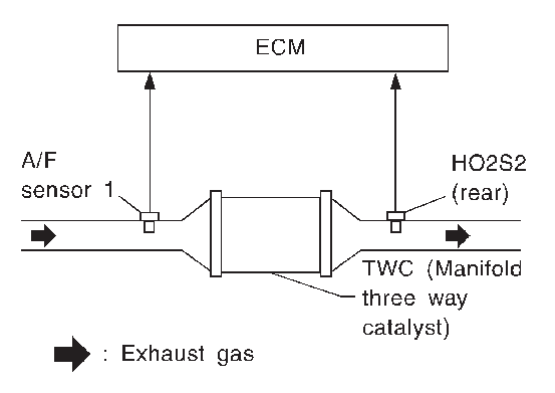DTC Description
DTC DETECTION LOGIC
The ECM monitors the switching frequency ratio of air fuel ratio (A/F) sensor 1 and heated oxygen sensor 2.
A three way catalyst (manifold) with high oxygen storage capacity will indicate a low switching frequency of heated oxygen sensor 2. As oxygen storage capacity decreases, the heated oxygen sensor 2 switching frequency will increase.
When the frequency ratio of air fuel ratio (A/F) sensor 1 and heated oxygen sensor 2 approaches a specified limit value, the three way catalyst (manifold) malfunction is diagnosed.
| DTC | M.U.T.-III SE screen terms (Trouble diagnosis content) | DTC detection condition | ||
| P0420 | 00 | TW CATALYST SYS-B1 (Catalyst system efficiency below threshold bank 1) | Diagnosis condition | — |
| Signal (terminal) | — | |||
| Threshold |
| |||
| Diagnosis delay time | — | |||
POSSIBLE CAUSE
- Three way catalyst (manifold)
- Exhaust tube
- Intake air leaks
- Exhaust air leaks
- Fuel injector
- Fuel injector leaks
- Spark plug
- Improper ignition timing
FAIL-SAFE
Not applicable
DTC Confirmation Procedure
1.PRECONDITIONING
If DTC Confirmation Procedure has been previously conducted, always perform the following procedure before conducting the next test.
- Turn ignition switch OFF and wait at least 10 seconds.
- Turn ignition switch ON.
- Turn ignition switch OFF and wait at least 10 seconds.
Will M.U.T.-III SE be used?
2.PERFORM DTC CONFIRMATION PROCEDURE-1
 With M.U.T.-III SE
With M.U.T.-III SETESTING CONDITION:
Do not hold engine speed for more than the specified minutes below.
- Start engine and warm it up to the normal operating temperature.
- Turn ignition switch OFF and wait at least 10 seconds.
- Turn ignition switch ON.
- Turn ignition switch OFF and wait at least 10 seconds.
- Start engine and keep the engine speed between 3,500 and 4,000 rpm for at least 1 minute under no load.
- Let engine idle for 1 minute.
- Select “DATA MONITOR” mode of “ENGINE” using M.U.T.-III SE.
- Check that “COOLANT TEMP/S” indicates more than 70°C (158°F).If not, warm up engine and go to next step when “COOLANT TEMP/S” indication reaches to 70°C (158°F).
- Open engine hood.
- Select "SRT STATUS" mode of "ENGINE" using M.U.T.-III SE.
- Rev engine up to 2,500 to 3,000 rpm and hold it for 3 consecutive minutes then release the accelerator pedal completely.
- Check the indication of “CATALYST”.
Which is displayed on M.U.T.-III SE screen?
3.PERFORM DTC CONFIRMATION PROCEDURE-2
- Wait 5 seconds at idle.
- Rev engine up to 2,500 to 3,000 rpm and maintain it until “INCMP” of “CATALYST” changes to “CMPLT” (It will take approximately 5 minutes).
Does the indication change to “CMPLT”?
4.PERFORM DTC CONFIRMATION PROCEDURE AGAIN
- Stop engine and cool it down to less than 70°C (158°F).
- Perform DTC confirmation procedure again.
5.PERFORM DTC CONFIRMATION PROCEDURE-3
6.PERFORM COMPONENT FUNCTION CHECK
 Without M.U.T.-III SE
Without M.U.T.-III SE- Start engine and warm it up to the normal operating temperature.
- Turn ignition switch OFF and wait at least 10 seconds.
- Restart engine and keep the engine speed between 3,500 and 4,000 rpm for at least 1 minute under no load.
- Let engine idle for 1 minute.
- Open engine hood.
- Check the voltage between ECM harness connector terminals as per the following condition.
ECM Condition Voltage (V) Connector + – Terminal F52 92 97 Keeping engine speed at 2500 rpm constant under no load The voltage fluctuation cycle takes more than 5 seconds. - 1 cycle: 0.6 - 1.0 → 0 - 0.3 → 0.6 - 1.0
Is the inspection result normal?
 -1To check malfunction symptom before repair: Refer to Intermittent IncidentIntermittent Incident
-1To check malfunction symptom before repair: Refer to Intermittent IncidentIntermittent Incident .
. -2Confirmation after repair: INSPECTION END
-2Confirmation after repair: INSPECTION END Proceed to DTC Diagnosis Procedure
Proceed to DTC Diagnosis Procedure .
.![[Previous]](../../../buttons/fprev.png)
![[Next]](../../../buttons/fnext.png)
